グローバルサイエンスと拠点都市「神戸」 |
| 灘五郷の酒醸造から京コンピュータに至るサイエンス&テクノロジーを確認しつつ,先端科学・安全・健康の視点から考察する。 |
|
Oct.
28-29, 2016
|
|
震災・復興とリスクマネジメント( )国際都市神戸と世界の文化( )提言:国際紛争・対立から平和・協調へ( )グローバルサイエンスと拠点都市神戸( ◯ )その他( )
[Title] 2nd Geopark fieldwork activities at San'in Kaigan Geopark
|
|
[Overview]Below is our 2nd Geopark fieldwork activities at San'in
Kaigan Geopark activity report.
1.Theme
Kobe University Secondary School SGH
program-"Global Science and Kobe as a Regional Core City"
This is an interactive program with
"Tottori Prefectural Iwami Senior High School" and "Tottori
University of Environmental Studies" about San'in Kaigan Geopark.
There is a wide range of landform・soil・climate and human life - Focusing on Kobe and
Iwami’s granite
2.
Purpose
On Nov.
17, 2015, UNESCO HQ had the 38th General Conference. Global Geoparks
Network(GGN) was supported by UNESCO, but from this day, GGN’s activities
were organized as “International Geoscience and Geoparks Program:IGGP”. From this background, we aimed at 3 targets
to learn from the beautiful nature of San’in Kaigan Geopark.
(1)
Learn the basics of the natural science through the fieldwork
activities.
(2)Cooperate and learn with Iwami Senior
High School and Tottori University of Environmental Studies and have a
feeling of closeness to the San’in Kaigan Geopark’s nature.
(3) Learn the difference of the climate and
history between the Pacific Ocean side-Kobe and Japan Sea side-Iwami. Focus
on the “granite” to develop the perspectives of geological science.
(4) Learn from the San’in Kaigan Geopark’s
precious nature, recognize how wonderful your local area is.
We will especially focus on 2 & 4.
3. Contents
(1)
Interactions with Tottori University of Environmental Studies.
(2) Fieldwork
in San'in Kaigan Geopark
Especially, we focused upon listening to local
community members to learn about the problems in the mountainous settlements (such
as aging society, abandoned farmlands, rice paddy field maintenance, etc.).
|
|
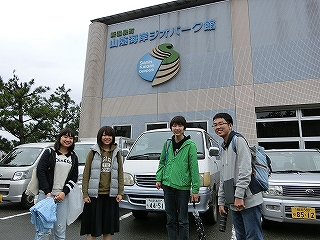
|
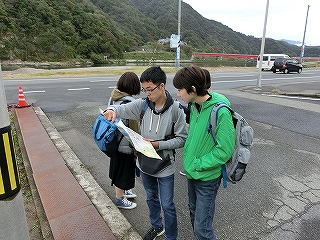
|
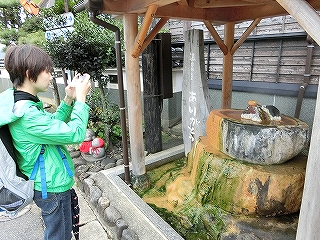
|
|
We
visited the Shinonsen Town San'in Kaigan Geopark Center to know more about
the geopark.
|
We did
a fieldwork activities in Shinonsen Town with maps in our hands.
|
We
found the source of the hot springs.
|
|
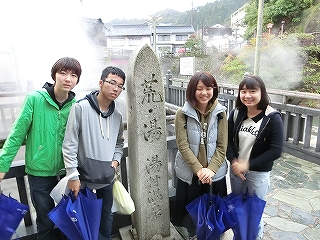
|
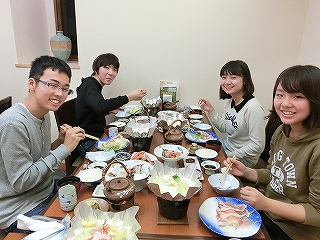
|
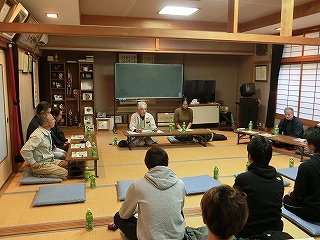
|
|
The source of hot springs in Shinonsen Town.
|
Delicious seafood. Thanks to the blessings of
San'in Kaigan.
|
Interaction
with the local people at Shinonsen Town-Haruki district.
|
|

|
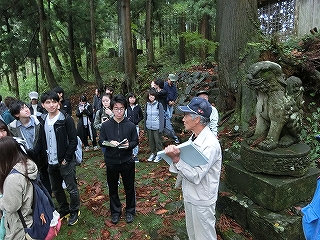
|
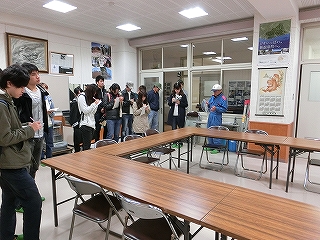
|
|
We
heard some stories from the Kinryuzan Manpukudera's master of the temple.
|
At the
Haruki Shrine, we are listening to the stories of this shrine.
|
Visit
to Haruki Elementary school (Now it
became a community center).
|
|
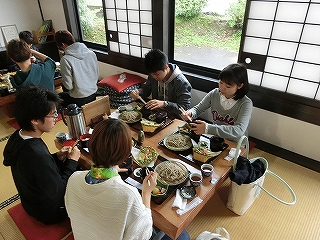
|
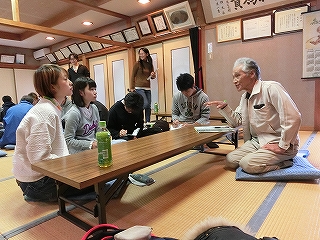
|
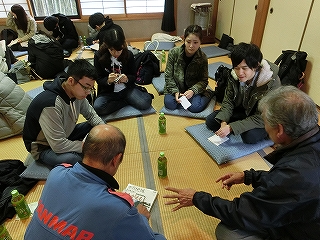
|
|
Haruki
district is famous for it's soba(buckwheat noodle).
|
We had
discussions with the local people about the 4 issues they are having problems
with.
(Team to discuss about the animal damage)
|
We had
discussions with the local people about the 4 issues they are having problems
with.
(Team to discuss how people can use the
Ex.Haruki Elementary School actively)
|
Student's comments
4th grade: K
This time we had 2 days to do the fieldwork. On
the first day, we visited Geopark center and did fieldwork at Shinonsen Town.
This made it possible for us to realize how the hot spring is useful in this
area. At Yumura Onsen, we were able to
realize how hot springs are used and how much water is coming out in a day.
On the
second day, we went to Haruki district. It was our first time to visit the
mountainous settlements, so it was very interesting to learn all the new things
there. I realized that people used to live there and work in various industries
using the local characteristic items, but now the area is having a depopulation
problem. I was able to know the actual condition of the area because we did the
fieldwork by ourselves. I would like to participate in this program
continuously.
4th grade: T
I had 3 effective study results. First, I was
able to know how a geopark will effect the area. I recongnized that these areas
were able to commercialize geopark, but I believe that they can deliver more messages
about how geoparks affect to our lives. Second, I was able to know more about
the local areas around the geopark. It was a valuable experience for me to
interact with the local people. Third, listening to the local peoples voices, I
was able to get new ideas and receive understandings. This experience was
really valuable for me so I am sure that I can use this in my future
activities.
5th grade: H
We were able to learn and feel the life around
the geopark by visiting the local area and hot springs. At the geopark center,
we learned the history of the Japan Sea. We were also able to touch the natural
resources such as sand and stones in San'in area. At the Yumura onsen, we
learned that the hot springs are not only the tourism resources but the life
resource of the local people. We were able to have discussions with the
university students and local people and I was happy to connect with them. I
would like to participate in this program again.
5th grade: T
On the first day, we walked around the beach. I
was able to feel the natural resource of Hamasaka Onsen. I realized that
Hamasaka Onsen has been providing various benefits to the local people and the
travelers.
On the second day, we did the fieldwork at Haruki
district with students from Tottori University of Environmental Studies.
When we had discussions with the local people, I said that the Ex elementary
school should be used as an art museum and show the artworks relating to their
area such as Ryuken Deguchi's artwork of dragon. I recongnized that the local people want to
make their area active, but the public administration will not say yes...I
believe that we should support the local people's reform and have a broad-minded
attitude to their activity.
|
June 24-July 2, 2016
|
|
UK-Cambridge
Study Tour
|
|
[Overview]Students will visit
cities in the UK (London and Cambridge). They will visit and participate in classes
and will also do fieldwork for their “Theme-based Research”. Students must
use English for communication. This will improve their English ability and
provide them with a chance to communicate in an international society. 2 male
students and 3 female students joined this program.
|
|
|
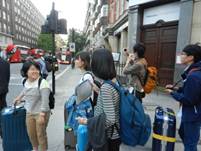
|
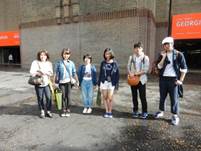
|
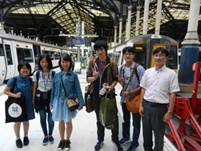
|
|
June 24 - It
took 20 hours to arrive in London.
|
June 25 -
Students divided into 2 groups to do the research for their studies. We all
gathered again at Tate Modern.
|
June 26 –
Students are going to Cambridge today.
|
|
|
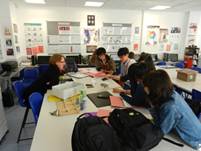
|
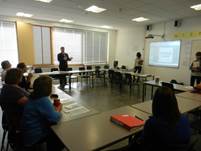
|
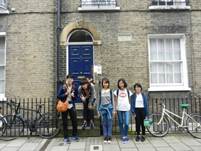
|
|
June 27 – We had
interactions with High School students in CVC.
|
June 28 –
Students did an Individual Research Presentation in front of the teachers in
CVC.
|
June 29 – Sightseeing
tour in Cambridge. Photo in front of the place where Charles Darwin lived.
|
|
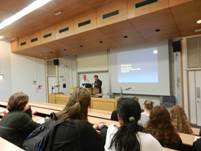
|
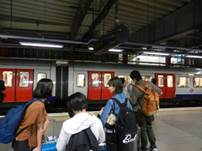
|
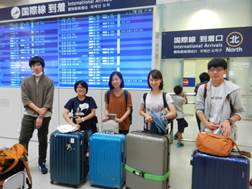
|
|
June 30 –
Students joined the Open Campus to experience student life is in England.
|
July 1
– The students are on their way to the airport.
|
July 2
– Back to Japan.
|
|
2016年6月20日
|
|
震災・復興とリスクマネジメント( )国際都市神戸と世界の文化( )提言:国際紛争・対立から平和・協調へ( )グローバルサイエンスと拠点都市神戸( ◯ )
[Title]1st Geopark fieldwork activities with
Tottori Prefectural Iwami Senior High School and Tottori University of
Environmental Studies
|
|
[Overview]
1 Theme
Fieldwork activities with Tottori
Prefectural Iwami Senior High School and Tottori University of Environmental
Studies in San’in Kaigan Geopark. Wide range of landform・soil・climate and human life - Focusing on Kobe and Iwami’s granite
2 Purpose
On Nov. 17, 2015, UNESCO HQ had the 38th General Conference.Global Geoparks
Network(GGN) was supported by UNESCO, but from this day, GGN’s activities
were organized as “International Geoscience and Geoparks Program:IGGP”. From this background, we aimed at 3 targets to learn from the
beautiful nature of San’in Kaigan Geopark.
(1) Learn the basics of the
natural science through the fieldwork activities.
(2)Cooperate and learn with Iwami Senior High
School and Tottori University of Environmental Studies and have a feeling of
closeness to the San’in Kaigan Geopark’s nature.
(3)Learn the difference of the climate and
history between the Pacific Ocean side-Kobe and Japan Sea side-Iwami. Focus
on the “granite” to develop the perspectives of geological science.
(4)Learn from the San’in Kaigan Geopark’s
precious nature, recognize how wonderful your local area is.
We will especially focus on 2 & 4.
|
|
 |
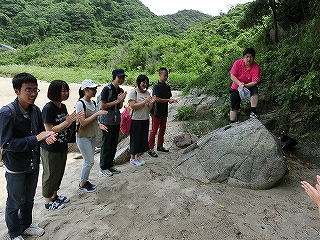 |
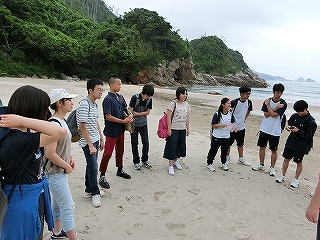 |
|
At JR Tottori Station.
|
Opening Ceremony in Kumaihama.
|
We learned about the landscape and
climate of Kumaihama.
|
|
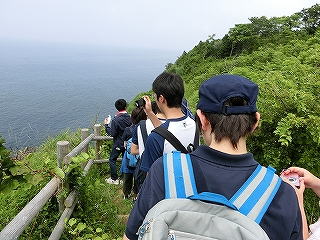 |
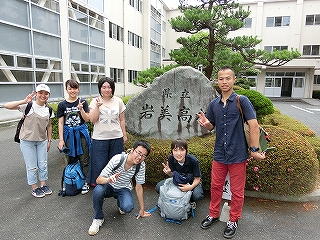 |
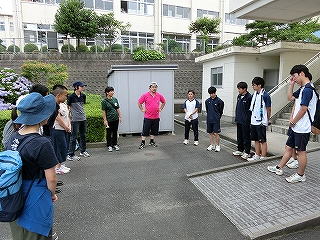 |
|
We climbed a steep hill to reach
Ryujindo.
|
At Tottori Prefectural Iwami Senior High
School.
|
Closing Ceremony
|


























